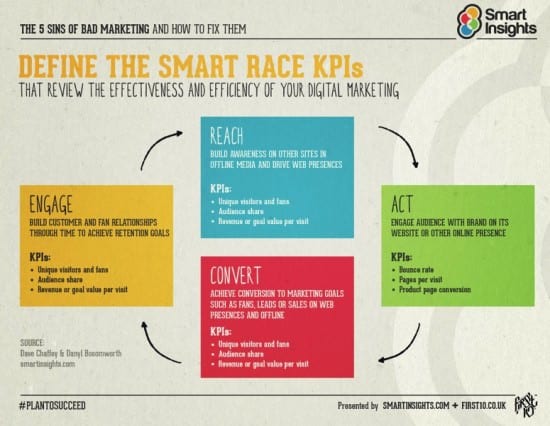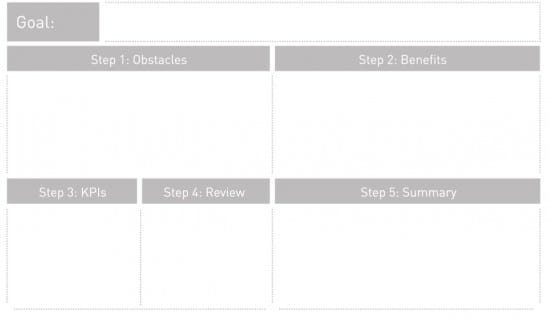5 Steps to empower your team to set relevant digital marketing goals

Budget planning. It comes around every year like clockwork. Most CMOs or Marketing directors are pivotal to business planning in the first place, but even after the business plan is formed business goals need to be translated into useful information for the marketing team to formulate their own plans and marketing objectives. If done well, this is a really empowering exercise for marketing teams and gets people out of their day-to-day job and into thinking about the bigger picture, even excited about the year ahead (good for staff retention). The post below outlines the 5 steps I go through to ensure that the marketing department are aligned and facing the same way as the business leaders, it assumes business goals are set and that you are including your team in creating marketing specific goals and strategies.
Step 1: Make sure your business goals are SMART
Having clear and strong business goals that marketing should align with is the first key thing to do. It may mean not showing all the goals, but also some finessing maybe required to make them understandable. Some strong business goals might be:
- Grow % of online sales from x to y which would mean a total of £z generated by the end of Q4 2015
- Introduce 3 x new product lines and ensure they make up 10% of total T/O by Q2 2015
- Increase customer LTV from X to Y by Q3 2015
- Successfully launch our brand into country X with an additional T/O contribution of 5% equating to £Y’s by Q3 2015
There a suite of goals that sit above all of these, such as total turnover and profit expectations but the above are things we can influence from a digital marketing perspective and therefore relevant to move things forward.
It's also worth noting with respect to digital marketing that it's not simply a case of developing digital marketing strategies that align - opportunities for digital impact and alignment should be reviewed, as Dan Bosomworth explains in this post.
Step 2: Remind the team of the company vision and how that translates to next years goals
Remembering that your team are usually knee-deep in their day-to-day work that they can often have lost sight of the business vision. Revisiting this and how it translates to the coming years goals is a key step in getting everyone excited about the coming brainstorm.
Your company vision should include your purpose, values and long-term aims of the company. To help arrive at the most appropriate goals you actually need to consider strategy enough to know the goals are right, the session outlined below shows you how you can get into enough detail to arrive at the most appropriate goals.
From a Digital Transformation POV, it can be useful to define a future digital vision as these example vision statements for digital marketing show.
Step 3: Utilise Smart Insights RACE planning to run a strategy session
This is probably the most fun part of a goal-setting session, depending on company size you may do this over several days. The RACE planning framework enables you to set goals and KPIs for each of Reach-Act-Convert and Engage as explained in the post and this diagram:

Ideally, this activity is done in one day and offsite (with follow-up actions naturally). To be offsite is important, any day-to-day distractions will ensure this is a productive day for all involved. The days agenda could break down like this:
- 09:30 - 10:30 - Business vision update and business goals
- 10:45 - 12:30 - In teams complete the strategic SWOT analysis & PEST exercises (have large print out versions with marker pens available)
- Complete each exercise in turn and ask teams to present back one another
- 13:30 - 15:00 - Finding solutions with context of the morning
- Considering different top level strategies by RACE to achieve a goal (diagram 1). Getting as many ideas and routes down as possible (30mins)
- Go through the process of kill, keeping or combing (if two are quite similar) possible routes until you arrive at a suite of routes to review (15mins)
- Take each approach and go through the 4 steps outlined in diagram 2 below (45mins)
- 15:15 - 16:00 - Review each teams approaches in their priority order (designate time to each team as needed)
- 16:00 - 16:30 - Co-create as a team a suite of approaches that you all believe would ensure business goals are met
- 16:30 - 17:00 - Agree the next steps and owners to arrive at the next sessions requirements
Step 4: Ensure you have the data to back up your strategy
After your workshop is complete it is crucial that each idea goes through a round of data validation to come up with scores as to the probability of hitting that particular goal. This is quite a skill in its self, understanding how you have performed previously with an overview of resources to achieve it and calculating how metrics would be impacted. Generally the output would be an excel forecast with listed assumptions next to it. This would then go through a suite of filters to rate by confidence on achieving what is needed.
Step 5: Review the final outputs as a team
Coming back together for a few hours once the number crunching is done is crucial to bring everything together so you can find a way to summarise your goals in 3-5 bullet points such as:
- We are going to grow our online reach through investment into paid media and our content to fuel social and search. We are monitoring this through new visitor growth and expect it to go from X to Y per month by end of the year
- Fixing the currently leaky bucket is key this year, through the NPD integration, optimisation for mobile devices and improved on-site content we aim to increase our conversion rate from visit to sale from 1.3% to 1.6% which with the increased traffic will mean an additional £X’s
Naturally there is then a wealth of work to do to put the finer plans and details in place to complete the planning and get on with it.
Diagram 1 - assigning Goals to RACE
Diagram 2 - Selecting the right goals

I will show a worked example of how we use this approach to goal setting in a future post.
If you would like the print-ready files for the diagrams at the bottom of the post (plus SWOT / PEST) please let me know we have them at First 10 as part of our strategy consultancy work.











